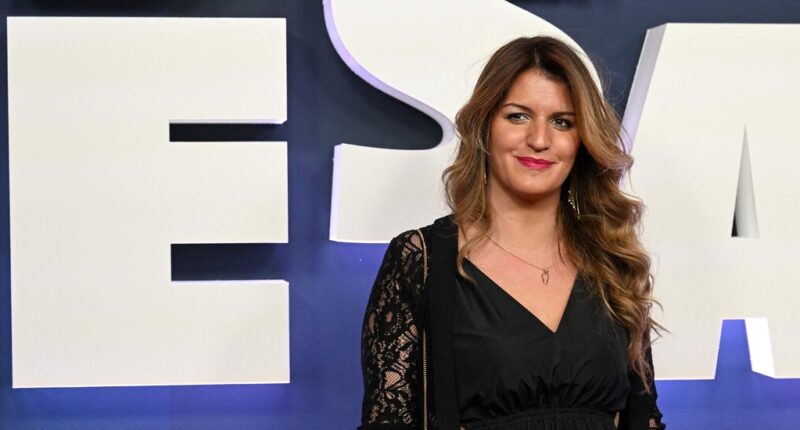
For almost a week, after word leaked that the French cabinet minister Marlène Schiappa would appear on the cover of French Playboy, the country’s talking heads have debated whether it is appropriate for a self-described feminist to appear in a magazine known for its nude centerfolds.
The prime minister rebuked the minister’s timing amid monthslong antigovernment protests. Ms. Schiappa’s colleagues in government raced to defend her. Others mumbled that they would not have chosen a publication packed with photos of naked women, but voilà.
On Thursday, the issue landed like a lead weight on newsstands.
There was Ms. Schiappa in a white dress on the cover, her right hand over her heart and cupping one breast. It was an allusion to the painter Eugene Delacroix’s symbol of French liberty, leading citizens over barricades, holding a rifle and the French flag, both breasts emerging from her unraveling dress.
“That wasn’t in our plans,” Ms. Schiappa’s communications assistant, Yenad Mlaraha, explained over the phone about the breast shot. “But the idea was to embody that spirit.”
In France, where a recent president sneaked off to his lover on a moped at night and another had a second secret family while running the country, the controversy has not involved morality, sex or even Ms. Schiappa’s blessing of threesomes (in both a government debate and the magazine interview).
Instead, the media storm has focused on the junior minister’s choice of publication, and critics have called the Playboy shoot a distraction.
“Why did you choose Playboy to advance women’s rights when this magazine is a compendium of all sexist stereotypes?” Isabelle Rome, the current junior minister of equality, told The Figaro newspaper. “Playboy will never be our ally.”
Olivier Véran, the government spokesman, said in the minister’s defense, “Marlène Schiappa leads a fight in favor of women’s rights that no one can take away from her or question.”
Many also questioned the cover at a time when the country was convulsed by waves of protests over the government’s new pension law, which increases the legal age of retirement to 64.
Prime Minister Elisabeth Borne saw fit to deliver a rebuke to Ms. Schiappa over the phone on Saturday, saying, “It wasn’t appropriate, particularly during this time.”
For the first three years of Emmanuel Macron’s presidency, when the #MeToo movement exploded around the world and ignited a furious debate in France, Ms. Schiappa was the government’s minister of gender equality. In July, she was named junior minister in charge of the social economy and volunteer life in France.
A prolific writer, Ms. Schiappa has published 10 books since joining the government in 2017. She has also released many erotic titles under a pseudonym, including “Dare the Female Orgasm.”
“It’s important that our shared erotic imagery should not be written solely by men,” she told Playboy.
Over a 12-page spread in the magazine, with six pages of answers to an interview, Ms. Schiappa appears in five photos, dressed in the national colors. She poses as iconic French figures, including Joan of Arc, dressed in a neck-to-calf metallic blue dress; and Louis XIV, in a billowing red cape that reveals one long leg.
In the long interview, she touches on feminism, conjugal violence, the sexual fulfillment of women, double standards in politics and the frustrating silence of the news media when she’s doing normal government business.
To the first printed question, “Why did you accept the invitation to talk to Playboy, this diabolical, divisive magazine?” she responds, “Women’s sexual liberty is a very important thing.”
“Women should be able to do what they want,” she added. “If they want to dress as nuns and never meet men, that’s their choice and we should support them. If they want to pose nude in a magazine, also. Even though, in my case, I will remain clothed.”
The Green lawmaker and ecofeminist Sandrine Rousseau called Playboy a heteronormative, macho magazine. But that, she insisted, was not the point. The point was that Ms. Schiappa had posed in the colors of the French Republic, when that very Republic was under extreme stress, she said.
“It’s not respectful of what is happening right now in society,” she said.
Ms. Schiappa has other worries. As the debate over her Playboy appearance swirled, an anti-radicalism fund she set up in 2021 to promote French Republican values and fight online extremism was accused of lax oversight in an investigation by two French news outlets.
Mr. Mlaraha, Ms. Schiappa’s communication adviser, denied the minister had done anything wrong, and said a recently opened criminal investigation would show that.
The art historian Maxime Georges Métraux saw paradoxes in Ms. Schiappa’s choice of Playboy portraits. While the minister talks of liberal values and freedoms, in two portraits she wears the obvious images of a conservative France, he said, pointing to Joan of Arc, a Catholic hero, and the country’s Sun King, Louis XIV, as represented by Hyacinthe Rigaud in a famous portrait.
Even her appearance as Delacroix’s “Liberty Leading the People” offered mixed messages, he said. “It’s the exaltation of the people and the revolutionary movement and the workers,” said Mr. Metraux. “She’s not the people.” The depiction of nudity in French painting indicated simplicity and transparency. But Ms. Schiappa’s portrait was “porno chic,” he said, and “very studied.”
As for Playboy, the magazine seemed positively delighted that the debate over Ms. Schiappa’s cover had rippled through France’s halls of power.
After Prime Minister Borne’s call to the junior minister was leaked to the news media, the magazine’s French editor, Jean-Christophe Florentin, said in an interview, “Élisabeth Borne was the magazine’s best press officer.”
Tom Nouvian contributed reporting.
Source: | This article originally belongs to Nytimes.com









